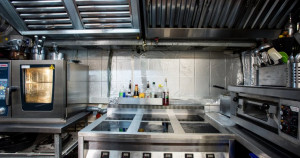Don't overlook kitchen repairs, maintenance
Posted on 10/01/2022 9:54 AM | by NaijaHouses

A tale as old as time: during peak service, the walk-in cooler stops cooling, the fryer fails, or the HVAC gives out. Rather than assisting the line, serving customers, or supporting employees, you must immediately find a quick fix to avoid lost inventory, unfilled orders, or an even hotter kitchen.
At quick-service restaurants, customers expect their experience to be fast and consistent. And now more than ever, safety, speed and convenience are essential to keeping customers coming back.
COVID-19 caused clear shifts in consumer behavior and preferences. Contactless pickup became standard. Drive-thru remains king. Technology continues to drive innovation.
Before the "restaurant of the future" arrives, it's important to address the elephant in the room — or rather, in the kitchen. Embracing technology to optimize the front-of-house experience — especially in today's competitive QSR landscape — is key to maintaining brand loyalty and meeting consumers' needs. However, back-of-house (specifically repairs and maintenance) is much slower to receive the attention and optimization needed to create the fast, convenient experience customers crave. But it's equally as critical.
To avoid a nightmare scenario in the middle of peak service, quick-service restaurants must focus on data-driven preventative maintenance plans. This is a crucial, make-or-break shift in your operations to ensure you're one step ahead of a breakdown that could cost your business big time.
Creating a preventive maintenance plan
Step one to building a preventative maintenance (also, proactive repairs or planned maintenance) plan that actually works is understanding what areas of your kitchen are either in most need of attention or would benefit most from simple preventative maintenance.
While preventative maintenance may seem time-consuming, emergency repair costs are much greater than time spent planning ahead. According to the National Restaurant Association in 2020, restaurant repairs can cost up to 1.5% of sales, while other studies note this can be even higher at 2% to 6%.
On paper, that may not seem like a large chunk of cash flow — but a few hours without a fryer means lost revenue, customer dissatisfaction, and a large bill for emergency service.
Planned maintenance decreases the need for dispatching a vendor outside working hours or impulsively replacing worn-down equipment. More likely, you'll be able to troubleshoot successfully and repair before replacing with well-done preventative maintenance.
Creating a schedule and sticking to it is essential. Many PM strategies can be done every 30/60/90 days, or once or twice per year. You should consider your restaurant's unique schedule, supporting seasonal menu changes or big promotions that drive increased sales, and subsequent wear and tear on your equipment.
Don't give cold side the cold shoulder
To start, cold side is not only a priority for quick-service restaurants, but the source of their most common equipment repairs. According to 2020 data from more than 7,000 service incidents, 35% of incidents were cold side equipment — most commonly walk-in coolers, reach-in refrigerators, and walk-in freezers. These incidents cost $668.30 on average.
Depending on your model, the average temperature for a walk-in cooler should be anywhere from 35 to 40 degrees Fahrenheit. When it exceeds this sweet spot, your product is at risk.
To complete preventative maintenance for your walk-in cooler, follow these helpful tips:
- Toggle the breaker off for one minute and turn it back on.
- Examine the evaporator for ice or first buildup and defrost the unit if needed.
- Clear the drain line with compressed air or a wet vacuum.
These help ensure you'll spot any problems before they turn into a full-on breakdown or require a vendor visit.
Second to cold side repairs, quick-service restaurants also face a high volume of service requests surrounding plumbing infrastructure. Although it may not seem as pertinent to QSRs compared to full-service restaurants, plumbing is more than just public restrooms.
How about that leaky dish sink your staff walks by every day that you haven't gotten fixed yet because it's "always been like that?" Pipe leaks can damage nearby equipment, waste water, hinder normal service, and increase your water bill. Larger leaks and bursts can cause permanent structural damage and put a location out of commission, sometimes for weeks.
Smaller leaks might cost anywhere from $150 to $300 to fix, but a larger leak in plumbing infrastructure can run you into the thousands. In the event of closing the doors for more than a few hours, the cost of lost business is devastating.
To complete preventative maintenance for your plumbing and infrastructure, follow these helpful tips:
- Conduct backflow testing and line jetting annually.
- Check water heaters bi-annually.
- Walk through with a plumber quarterly.
- Make sure grease traps are clear and pipes are free of buildup. Use drain grates to keep lines clear, ensuring they're properly fitted.
- Pay attention to sounds—a strange draining sound is your first sign to examine plumbing lines for a deeper issue.
- Regularly clean hood fans, belts, and pulleys. Frequency varies by municipality inspection requirements and unit specifications.
Preventative maintenance won't just save you and your staff time (which you need now more than ever), but inventory and revenue, too. Equipment repairs are inevitable, but proactive, data-driven facilities management can maximize the time, money, and energy available for managing last-minute mishaps and conquering your day-to-day.
As technology advances and improves the front-of-house experience, consider embracing solutions to optimize your back-of-house processes. Increasing efficiency in the elusive R&M process may seem impossible, but with the right tools at your disposal, you can plan, troubleshoot, and strategize to better your business.
Source:qsrweb